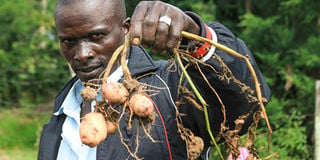Agronomist notebook: Use this test to spot bacterial wilt in potatoes

Peter Musyoka displays potato tubers infected with bacterial wilt and parasitic nematodes in his farm in Nyeri in this past photo. The bacteria causing the disease enters the plant through weak points or wounds caused by abrasion or nematodes. FILE PHOTO | NMG
What you need to know:
- Potatoes grow mostly in high-altitude areas that receive high amounts of rainfall.
- Most farmers use farm-saved seeds, a practice that has been blamed for rise in diseases and poor yields. It is important to go for certified seeds for the best harvest.
- One disease that hits potato farmers the hardest is bacterial wilt. The bacteria enter through the weak points or wounds caused by abrasion or nematodes.
- Bacterial wilt is easily spread by infected tubers, soil, water, plant debris or contaminated machinery. The bacteria can easily survive in tubers that remain in the ground after harvesting.
Potato is one of the most important food crops in Kenya, coming second after the staple maize.
Demand for the tuber has been rising over the years due to increased consumption, especially of potato chips and crisps.
Potatoes grow mostly in high-altitude areas that receive high amounts of rainfall.
However, they can also be grown under irrigation, in particular, the drip irrigation system in dry areas. The main varieties include Shangi, Tigoni and Kenya mpya.
As a good practice, potatoes should be planted on land where members of the Solanaceae family (tomatoes and black nightshade), have not previously been grown.
In places where farmers are relying on rainfall, timely planting is necessary to maximise on rains.
Most farmers use farm-saved seeds, a practice that has been blamed for rise in diseases and poor yields. It is important to go for certified seeds for the best harvest.
The land should be prepared to a fine tilth and raised beds made for one to achieve uniform, large and smooth tubers.
The seeds should be placed in 8-12cm depth furrows with the sprouts facing up for uniform germination. Inter-row spacing should be 75cm and 30cm for intercrop distance.
But before planting, do a soil analysis to establish nutrient availability and to rule out pathogens that result in soil-borne disease.
EMPLOY CROP ROTATION
Depending on the analysis, consider using Di-ammonium phosphate for planting. During the second weeding, earthing up should be done to prevent greening of the exposed tubers and waterlogging in flooded areas.
One disease that hits potato farmers the hardest is bacterial wilt. The bacteria enter through the weak points or wounds caused by abrasion or nematodes. Also, the disease can arise from infected mother tubers.
To confirm presence of bacterial wilt in potatoes, cut a tuber or the stem and suspend it in a glass of water for some time. If a whitish substance oozes out, it shows the presence of bacterial wilt.
The bacteria spread from the infected roots or mother tubers through the vascular systems to other parts of the plant.
The diseased tubers have gummy or sticky eyes, which exude white fluid where the soil tends to stick. Also, brown rot in the vascular ring is visible if the tuber is sliced in half, which renders the crop unfit for human consumption.
There is no effective chemical treatment for the disease. However, the farmer should control it by rotating crops and practising farm hygiene, such as disinfecting farm tools.
Bacterial wilt is easily spread by infected tubers, soil, water, plant debris or contaminated machinery. The bacteria can easily survive in tubers that remain in the ground after harvesting.
Therefore, remove all tubers while harvesting and employ crop rotation to remove volunteer crops.
Infested plant residues should not be used to make compost as the bacteria can survive and affect crops.
Other potato diseases include early and late blight and pests such as aphids.
Potatoes are ready for harvest after 75-100 days, depending on the variety.





